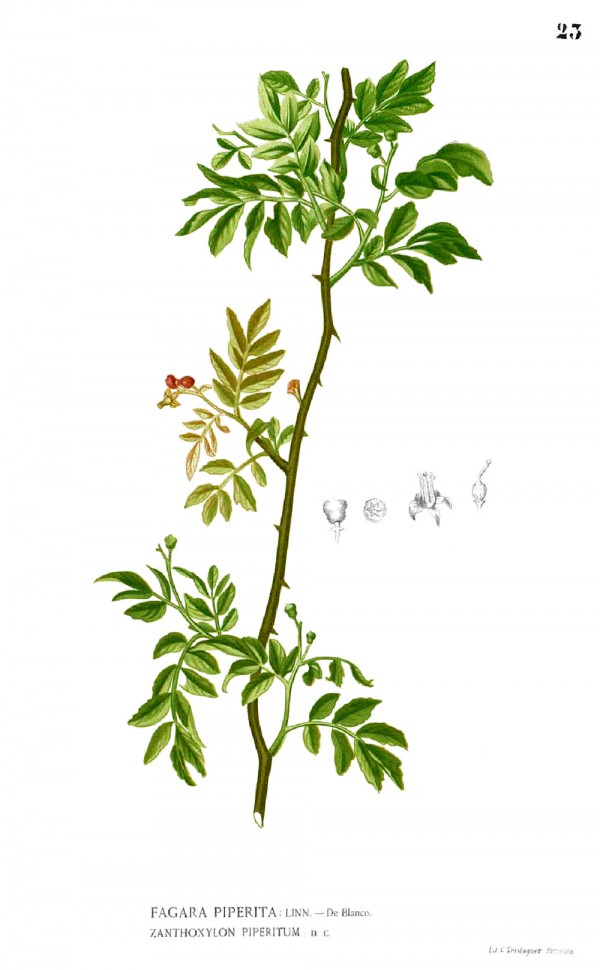Benutzer-Werkzeuge
Zanthoxylum piperitum DC. - syn.Xanthoxylum piperitum DC. - Rutaceae - Japanese Pepper, Japanischer Pfeffer, „Szechuanpfeffer“
Deciduous shrub, up to 2m high, with tiny (5mm) yellow-green flowers; native to Japan, the Korean peninsula and China.
„It is dioecious, and the flowers of the male plant can be consumed as hana-sanshō, while the female flowers yield berries or peppercorns of about 5mm. For commercial harvesting, thornless varieties called the Asakura sansho are widely cultivated. Around September to October, the berries turn scarlet and burst, scattering the black seeds within… The plant is important commercially. The pulverized mature fruits („peppercorns“ or „berries“) known as „Japanese pepper“ or kona-zanshō (Japanese: 粉ざんしょう). This is the standard spice for sprinkling on the broiled eel (kabayaki unagi) dish. It is also one of the seven main ingredients of the blended spice called shichimi, which also contains red chili peppers.“ https://en.wikipedia.org/wiki/Zanthoxylum_piperitum
„The degree of pungency and amount of a sanshool showed a positive correlation. In young leaves and flowers, the degree of pungency was less than that in the fruits, the main compound being α-sanshool, while the two hydroxy sanshools were detected only in trace amounts. The main compound in fruits was hydroxy α-sanshool, whose threshold value was higher than that of α-sanshool. It is concluded that the pungency of Japanese pepper should be evaluated not only by the threshold values, but also by the pungent qualities, the composition of sanshools, and the usage of each product of Japanese pepper.“
[Quantitative analysis of sanshool compounds in Japanese pepper (Xanthoxylum piperitum DC.) and their pungent characteristics. Sugai, Etsuko, Yasujiro Morimitsu, and Kikue Kubota. Bioscience, biotechnology, and biochemistry Vol.69 (10), 2005, 1958-1962]
Major components in the essential oil of fruit peel of Korean specimens were 1,8-cineol (25.4%), limonene (11.9%), geranyl acetate (9.0%), and myrcene (6.1%).
[Flavor components of the fruit peel and leaf oil from zanthoxylum piperitum DC. Kim, J. H., et al., Korean Journal of Food Science and Technology (1989)]
„Volatile compounds in the methanol extract of young leaves and green fruits of Japanese pepper (Zanthoxylum piperitum DC) were separated on an adsorptive column method. … The oil concentration of green fruits was 6200 ppm +- 5700 ppm, which means average value and standard deviation, and beta-phellandrene, d-limonene, and beta-pinene accounted for 42%, 23% and 11% of total oils, respectively.“
[Volatile aroma compounds in young leaves and green fruits of Japanese pepper [Zanthoxylum piperitum]. Wu, Y., M. Shimoda, and Y. Osajima. Journal of the Agricultural Chemical Society of Japan (Japan) (1996)]
„Amides bearing an alkyl- or alkoxy-substituted phenylethylamine residue displayed a clean umami taste as 20 ppm solutions in water. Ultraperformance liquid chromatography coupled with a high quadrupole-Orbitrap mass spectrometer (UPLC/MS) was subsequently used to show the natural occurrence of these amides. (E)-3-(3,4-Dimethoxyphenyl)-N-(4-methoxyphenethyl)acrylamide was shown to occur in the roots and stems of Zanthoxylum piperitum, a plant of the family Rutaceae growing in Korea, Japan, and China.“
[Frerot, Eric, et al. „New Umami Amides: Structure-Taste Relationship Studies of Cinnamic Acid Derived Amides and the Natural Occurrence of an Intense Umami Amide in Zanthoxylum Piperitum.“ Journal of agricultural and food chemistry 63.32 (2015): 7161-7168]

Blanco, M., Flora de Filipinas, t.23 (1875)
http://plantgenera.org/species.php?id_species=1081045
https://commons.wikimedia.org/wiki/Zanthoxylum_piperitum
